Arc Moonlight: all-octal tubes and twice the power
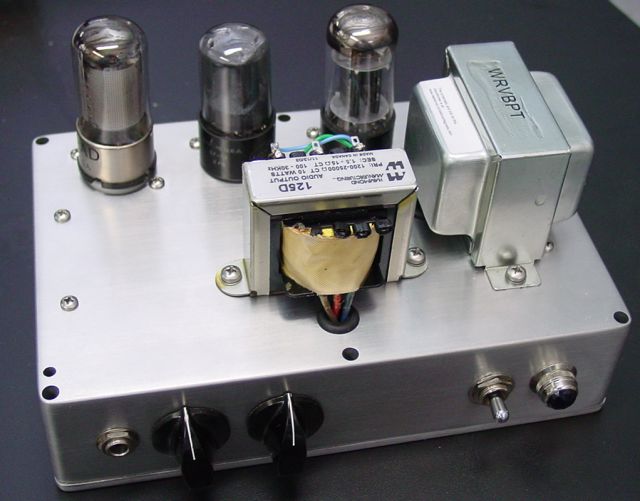
Simcha Delft's Moonlight guitar amp design offers a pleasing range of classic rock distortion tones, but it doesn't have much clean headroom. One way to get more clean volume would be to run at a higher voltage, with a lower mu output tube. So I cooked up this minor variation with the very hefty 6BL7GT dual triode taking over output chores from the standard 6SN7GT. The power transformer is a Weber VST WRVBPT. Designed to power the ReVibe standalone tube reverb/vibrato unit, the HV secondary is rated for 260V @ 100 mA with 6.3 VCT @ 3A for filaments. This low-cost ($US 15) transformer is good for low power amps up to10 watts. Since there is no center tap on the HV, a full wave bridge rectifier is used, and gives about 370 VDC with no load. The output transformer is a Hammond 125D, rated for 10W output. Using output terminals 3 & 6, the primary impedance is 6800 ohms into an 8 ohm load.
Construction details
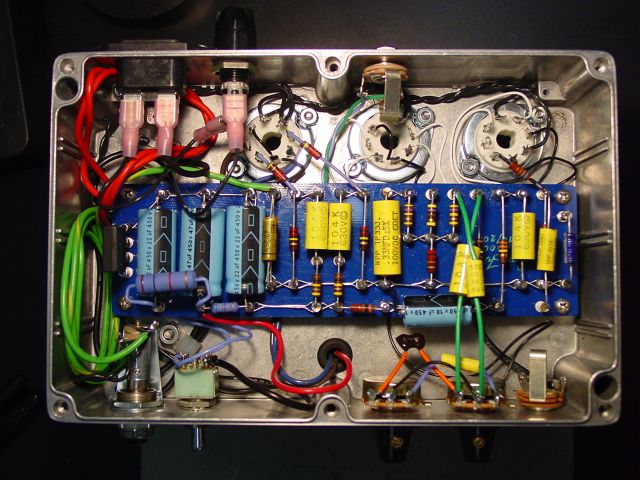
The turret board layout is nearly identical to the one I made for my first Moonlight, except I needed another component space for the silicon bridge rectifier on the power supply end. I made room for the rectifier by shifting all the components down 3/8 inch, placing the preamp cathode resistor and bypass cap neatly between the standoff mounting screws.
I deviated on the tone control as well, because I wanted a larger treble boost/cut range than provided by the original design. Borrowing the tone control circuit from the 18 Watt Lite IIa accomplished this nicely. I used 1M ohm pots instead of the specified 500K ohm, because that's what I had on hand.
While I was happy with the tone from several of the 9 pin miniature pentodes (EF80, EF184, EF183), I decided to try an octal pentode for the preamp. I first tried a metal 6SH7, which is electrically similar to the 7 pin mini 6AU6. Not surprisingly, it was microphonic. The friendly people at Radio Daze set me up with a beautiful mesh plate glass octal KenRad 6SH7GT. It sounds very sweet with the same values for cathode, plate, and screen resistors as Simcha's original design. RadioDaze is also my source for Hammond transformers and NOS tubes. The octal sockets are the inexpensive ceramic ones from Weber VST and can be either top or bottom mounted. To bottom mount them, the cutouts in the ceramic had to be ground a little with a Dremel for the mounting ears to fit properly.
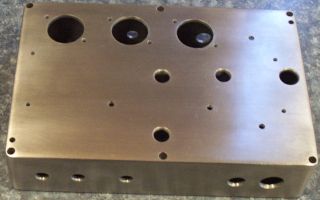
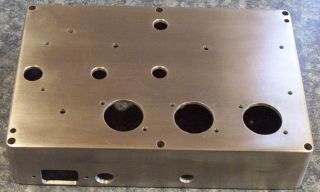
Once again, I chose a Velleman G-124 die-cast aluminum box for the enclosure. A Greenlee chassis punch made the octal holes, the #4 unibit handled the other control holes. Arpad made short work of the IEC connector hole with the Bridgeport mill.

The turret board is 7.75" x 2.25" constructed on 0.125" G10-FR4 glass-epoxy (aka Garolite) from McMaster-Carr. The Keystone turret lugs are Mouser Electronics part 534-1509-4.
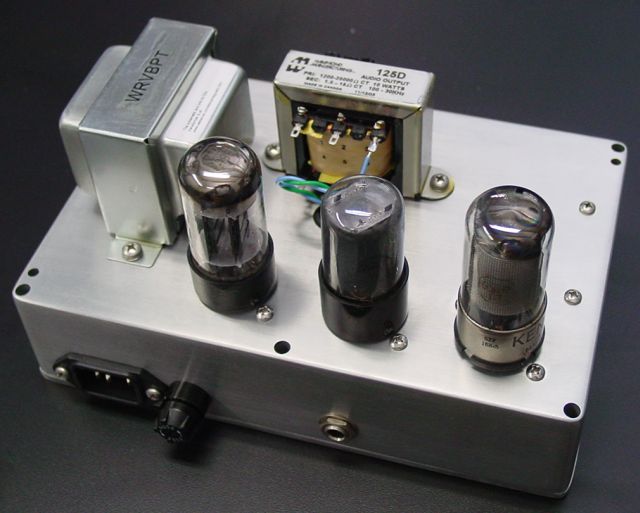
Tubes, from left to right:
The Hammond 125D output transformer is driven by a 6BL7GT dual triode in push-pull mode. B+ off the second filter node is 312VDC, and is cathode biased with a 3W 470 ohm resistor. Drawing 16 mA per section, idle dissipation of both sections together is 10W, or 2W below the rated maximum of 12W. The 6BL7 (mu=15) and the similar 6BX7 (mu=10) dual triodes served as vertical oscillator/vertical deflection amp in black and white televisions. The 6BX7 provides even more clean headroom, but draws about 40 mA with the same cathode resistor. Both tubes have gained favor as driver tubes for high end audio applications.
The phase inverter is a 6SL7GT in a conventional Schmidt pair configuration, run from 280VDC off the third filter node.
The preamp gain stage is a 6SH7GT, a glass envelope small signal pentode more frequently seen with a metal shell. This glass specimen is less microphonic than the metal one I tried first, with the added bonus of a nice filament glow through the big mesh plate. And speaking of glow, the 1.5A filaments in the 6BL7 add a warm and toasty ambiance to the amp. I've found that the 6SJ7 pentode also gives a pleasing tone, and required no circuit changes other than tying the supressor grid (pin 3) to cathode (pin 5) on the socket. These are internally connected in the 6SH7.
Turned up all the way, my stock Moonlight with the 6SN7 (mu=20) output tube nicely fills a bedroom or living room with creamy distortion. The higher power 6BL7/6BX7 makes this version way louder, with slightly less compressed crunch. It drifts away from the original designer's intent to create an "indoor/back porch" amp that can go up to 11 without causing major hearing damage. But it succeeds in delivering more clean volume than the original design, with the same basic tone.
To find out whether Arc-Moonlight could be tamed for bedroom shredding with a lower power output tube, I re-installed a 6SN7-GTB. With a 50V higher B+ than my stock Moonlight, the plate voltage is 326V, the cathode voltage is 10.6, and the combined plate current is 22.5 mA. The idle dissipation is 7.1W, just under the 7.5W maximum specification. Note: the original 6SN7-GT is only rated for 5W, and would probably fry in this situation. The volume level is sane again - a little louder than the original, and the tone slightly brighter due to the higher plate voltage.
I am pleased that the Moonlight design offered so many possibilities for varying the preamp and power tube without changing the circuit, and no doubt there are many component values in the preamp, phase inverter, and tone stack to tweak to one's individual taste. I like it just the way it is - nice tones with the knobs in any position, with single coil pickups or humbuckers, with pedals or without.